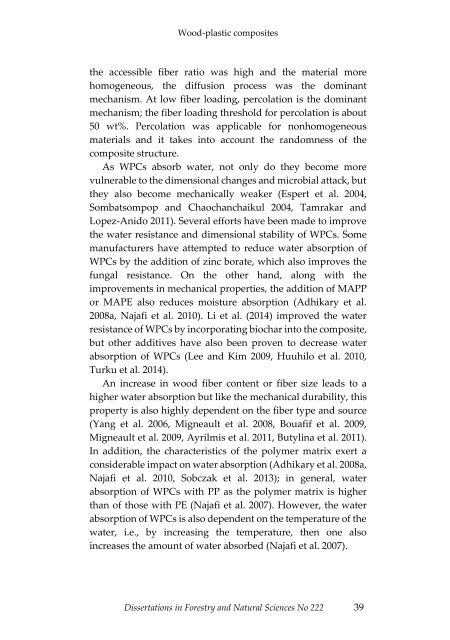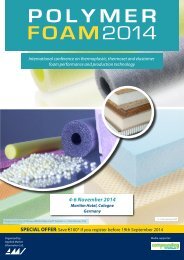Dissertations in Forestry and Natural Sciences
24lYKFN
24lYKFN
Create successful ePaper yourself
Turn your PDF publications into a flip-book with our unique Google optimized e-Paper software.
Wood-plastic composites<br />
the accessible fiber ratio was high <strong>and</strong> the material more<br />
homogeneous, the diffusion process was the dom<strong>in</strong>ant<br />
mechanism. At low fiber load<strong>in</strong>g, percolation is the dom<strong>in</strong>ant<br />
mechanism; the fiber load<strong>in</strong>g threshold for percolation is about<br />
50 wt%. Percolation was applicable for nonhomogeneous<br />
materials <strong>and</strong> it takes <strong>in</strong>to account the r<strong>and</strong>omness of the<br />
composite structure.<br />
As WPCs absorb water, not only do they become more<br />
vulnerable to the dimensional changes <strong>and</strong> microbial attack, but<br />
they also become mechanically weaker (Espert et al. 2004,<br />
Sombatsompop <strong>and</strong> Chaochanchaikul 2004, Tamrakar <strong>and</strong><br />
Lopez-Anido 2011). Several efforts have been made to improve<br />
the water resistance <strong>and</strong> dimensional stability of WPCs. Some<br />
manufacturers have attempted to reduce water absorption of<br />
WPCs by the addition of z<strong>in</strong>c borate, which also improves the<br />
fungal resistance. On the other h<strong>and</strong>, along with the<br />
improvements <strong>in</strong> mechanical properties, the addition of MAPP<br />
or MAPE also reduces moisture absorption (Adhikary et al.<br />
2008a, Najafi et al. 2010). Li et al. (2014) improved the water<br />
resistance of WPCs by <strong>in</strong>corporat<strong>in</strong>g biochar <strong>in</strong>to the composite,<br />
but other additives have also been proven to decrease water<br />
absorption of WPCs (Lee <strong>and</strong> Kim 2009, Huuhilo et al. 2010,<br />
Turku et al. 2014).<br />
An <strong>in</strong>crease <strong>in</strong> wood fiber content or fiber size leads to a<br />
higher water absorption but like the mechanical durability, this<br />
property is also highly dependent on the fiber type <strong>and</strong> source<br />
(Yang et al. 2006, Migneault et al. 2008, Bouafif et al. 2009,<br />
Migneault et al. 2009, Ayrilmis et al. 2011, Butyl<strong>in</strong>a et al. 2011).<br />
In addition, the characteristics of the polymer matrix exert a<br />
considerable impact on water absorption (Adhikary et al. 2008a,<br />
Najafi et al. 2010, Sobczak et al. 2013); <strong>in</strong> general, water<br />
absorption of WPCs with PP as the polymer matrix is higher<br />
than of those with PE (Najafi et al. 2007). However, the water<br />
absorption of WPCs is also dependent on the temperature of the<br />
water, i.e., by <strong>in</strong>creas<strong>in</strong>g the temperature, then one also<br />
<strong>in</strong>creases the amount of water absorbed (Najafi et al. 2007).<br />
<strong>Dissertations</strong> <strong>in</strong> <strong>Forestry</strong> <strong>and</strong> <strong>Natural</strong> <strong>Sciences</strong> No 222 39



